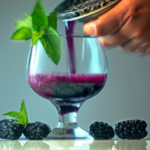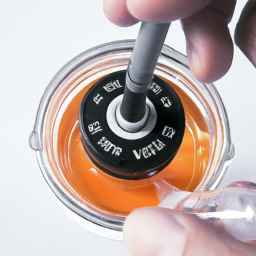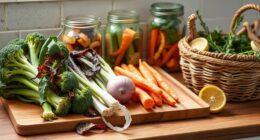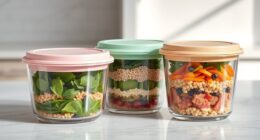Hi there, I’m thrilled to walk you through my method for crafting amazing muscadine juice. Muscadines, a grape variety indigenous to the southeastern U.S., produce an incredible juice that strikes the perfect balance between sweetness and tartness. By following a handful of straightforward steps, you can savor this delightful beverage throughout the entire year.
Firstly, it’s important to gather your muscadine grapes. You want ripe grapes that are soft to the touch and have a deep purple or bronze color.
Next, you’ll extract the juice by either using a juicer or by boiling the grapes and then pressing them through a sieve or cheesecloth. Once you have the juice, you’ll strain it to remove any seeds or pulp and then sweeten it to your taste.
From there, you can add additional flavors and spices such as cinnamon or ginger, chill the juice, and then serve and enjoy!
Key Takeaways
- Ripe grapes with a deep purple or bronze color are best for making muscadine juice.
- Muscadine juice can be extracted using a juicer or boiling and pressing through a sieve or cheesecloth.
- Add flavors like cinnamon, ginger, mint, or citrus fruits to enhance the taste of muscadine juice.
- Muscadine juice is packed with antioxidants, vitamins, and minerals and may have anti-inflammatory properties and promote heart health.
Gather Your Muscadine Grapes
Get ready to feel the excitement of the harvest as you gather your muscadine grapes! Before you start, make sure you’ve identified the right grape variety for the juice. Muscadine grapes come in different varieties, and not all are suitable for making juice. Select the ones that are sweet and juicy, and have a deep color.
To harvest the grapes, use harvesting techniques that will ensure the fruits are not damaged. Start by cutting off the clusters of grapes from the vines using pruning shears. Be careful not to crush the grapes as you remove them from the vines.
Once you’ve collected all the grapes, clean them by rinsing them under water to remove any dirt or debris. Now that you’ve got your grapes ready, it’s time to extract the juice.
Extract the Juice
Now it’s time to squeeze the goodness out of those plump little fruits, so roll up your sleeves and give it your all – you’ll be glad you did!
To extract the juice from muscadine grapes, there are a few different methods you can try. One option is to use a fruit press, which can be purchased or rented from a home brewing or winemaking supply store. This method involves crushing the grapes in the press to release the juice, then using the press to squeeze out as much liquid as possible.
Another alternative extraction method is to use a juicer or blender. If using a juicer, simply feed the grapes through the machine to extract the juice. If using a blender, blend the grapes until they’re thoroughly crushed, then strain the mixture through a cheesecloth or fine-mesh sieve to separate the liquid from the pulp.
Once the juice has been extracted, it can be used in a variety of recipes, from sweet desserts to savory marinades. Now that we’ve got our juice, it’s time to move on to the next step: Straining the Juice.
Strain the Juice
To get the most out of your muscadine grape harvest, you’ll want to strain the juice to remove any remaining pulp or seeds. Straining the juice will give it a smoother consistency and make it easier to drink.
There are several straining techniques you can use, depending on the tools you have available and the level of pulp you want in your juice. One popular method for straining muscadine juice is to use a cheesecloth. Simply pour the juice through the cheesecloth into a container and let it strain for several hours. This will remove most of the pulp and seeds, leaving you with a smooth, liquid juice.
Another option is to use a fine mesh strainer or sieve. This will also remove most of the pulp and seeds, but may leave a slightly thicker consistency to the juice. Experiment with different straining techniques to find the one that works best for you.
Once your juice is strained, it’s time to sweeten to taste.
Sweeten to Taste
Once the juice is free of any unwanted pulp, it’s time to add a touch of sweetness to make it a refreshing summer treat. Experiment with different sweeteners to find your preferred taste. Some people prefer to use sugar, while others prefer honey or agave nectar. You can also try using a mixture of sweeteners to customize the flavor profile.
It’s important to remember that a little sweetness goes a long way, so start with a small amount and adjust as necessary. When adding sweeteners, start by adding a small amount and tasting the juice as you go. This’ll allow you to adjust the sweetness to your liking. If you prefer a sweeter juice, add more sweetener until you reach your desired taste.
Once you’ve added your sweeteners, stir the juice well to ensure that it’s evenly distributed. Now that the juice is sweetened to your liking, it’s time to add additional flavors and spices to enhance the flavor profile even further.
Add Additional Flavors and Spices
Now that I’ve learned how to make muscadine juice, I’m excited to experiment with different flavors and spices to give it a unique twist.
Adding different fruits, such as peaches or strawberries, can enhance the taste and add a fruity sweetness.
Spices like cinnamon or nutmeg can give the juice a warm, comforting flavor.
Experimenting with Different Flavors
Mixing different flavors into your homemade muscadine juice can add a fun and exciting twist to your traditional recipe, leaving your taste buds craving more. When it comes to flavor pairing, it’s important to consider the balance of sweet and tart, as well as complementary flavors.
Here are some ideas to get you started:
- Add a hint of ginger for a spicy kick
- Mix in some fresh mint for a refreshing twist
- Experiment with citrus fruits like lemon or lime to add a tangy zing
Once you’ve added your desired flavors, be sure to taste test along the way to ensure you’re achieving the perfect balance. Don’t be afraid to adjust or add more as needed to suit your personal preferences.
Now that you’ve experimented with different flavors, it’s time to take it up a notch and add some spices for a unique twist.
Adding Spices for a Unique Twist
Spice up your life and take your tastebuds on a flavorful adventure by adding a pinch of cinnamon or a dash of nutmeg to your muscadine concoction. These spices offer a warm, earthy flavor that pairs perfectly with the sweetness of the grapes.
Other spice pairing suggestions include cloves, ginger, and cardamom. One of the benefits of using fresh spices is that they provide a more intense and complex flavor profile compared to their pre-ground counterparts.
To use fresh spices, simply grind them with a mortar and pestle or a spice grinder before adding them to your muscadine juice. This way, you can control the amount and ensure that the spices are evenly distributed throughout the juice.
With the addition of these aromatic spices, your muscadine juice will be transformed into a unique and delicious beverage that is sure to impress your friends and family. Now, it’s time to chill the juice and enjoy its refreshing goodness.
Chill the Juice
Before you can enjoy the refreshing taste of muscadine juice, you’ll want to chill it in the refrigerator for a few hours to enhance the flavor and create a more satisfying drinking experience. This step is important because chilled juice is more palatable and easier to drink, especially on a hot summer day.
Chilling the juice also helps to mellow out any tart or bitter flavors that may be present, resulting in a smoother and more balanced taste. Using muscadine juice in cocktails is a great way to add a unique twist to your drinks. Simply mix the chilled juice with your favorite liquor and add some ice for a refreshing and flavorful cocktail.
Additionally, pairing muscadine juice with food can take your meal to the next level. The sweet and tangy flavor of muscadine juice pairs well with a variety of dishes, including grilled meats, salads, and desserts.
Now that you’ve chilled your juice, it’s time to serve and enjoy!
Serve and Enjoy
Now it’s time to sit back, relax, and savor the refreshing taste of your chilled muscadine juice. Here are some presentation tips and serving suggestions to help you enjoy your homemade juice even more:
-
Serve chilled: Muscadine juice tastes best when served cold, so make sure to keep it in the refrigerator until you’re ready to serve it.
-
Serve in a tall glass: To fully appreciate the rich flavor and intense color of muscadine juice, serve it in a tall glass. This’ll also allow you to see the beautiful hues of the juice as it blends with the ice.
-
Add a garnish: For a pop of color and extra flavor, add a slice of lemon, lime, or a sprig of fresh mint to your glass.
After enjoying your muscadine juice, it’s important to store the remainder properly.
Storing the Juice
When it comes to storing muscadine juice, there are two main options: refrigerating for short-term storage or freezing for long-term storage. Personally, I prefer to refrigerate the juice if I plan to consume it within a week or so. This helps to maintain its freshness and flavor.
However, if I want to enjoy the juice later on, freezing it is the best option as it can last for several months without losing its taste or quality.
Refrigerating for Short-Term Storage
To keep your muscadine juice fresh, treat it like a delicate flower and store it in the refrigerator. Refrigeration is one of the short-term storage alternatives to preserve the freshness of your muscadine juice. It’s essential to refrigerate the juice immediately after making it to prevent the growth of bacteria and yeast. A good rule of thumb is to consume the juice within 2-3 days of refrigeration. If you plan to store it longer, you can freeze it for long-term preservation.
When refrigerating your muscadine juice, ensure that the container you use is airtight to prevent air from entering, which can lead to oxidation. You can use a glass jar or a plastic container with a tight-fitting lid. Make sure to label the container with the date of storage and the expiry date.
When you’re ready to consume the juice, shake it well to mix any sediment that may have settled at the bottom.
To preserve the freshness of your muscadine juice for a more extended period, you can freeze it. Freezing is a more reliable method of storage that can extend the shelf life of your juice up to a year. Let’s discuss the process of freezing the muscadine juice in the subsequent section.
Freezing for Long-Term Storage
If you want to keep your muscadine juice fresh for an incredibly extended duration, freezing it is the most reliable method. Freezing benefits your muscadine juice by preserving its nutrients, flavor, and color. It also prevents the growth of microbes that can spoil the juice.
Before freezing, make sure to remove any pulp or debris that may have accumulated during the juice-making process. Use a clean, airtight container suitable for freezing to store your muscadine juice. Fill the container to the top, leaving a little space for the juice to expand as it freezes. Seal the container tightly, and label it with the date of freezing.
Freezing process involves setting your muscadine juice in the freezer and waiting until it solidifies. The time it takes for the juice to freeze depends on the freezer’s temperature and the volume of juice. Typically, it takes two to four hours for a small container of juice to freeze, and up to eight hours for a larger container.
Once frozen, your muscadine juice can stay fresh for up to six months. When ready to use, remove the container from the freezer and allow it to thaw naturally in the refrigerator. Don’t thaw the juice at room temperature, as this could cause it to spoil.
With your muscadine juice frozen and stored, we can now move on to the subsequent section about the health benefits of muscadine juice.
Health Benefits of Muscadine Juice
Muscadine juice is packed with antioxidants, making it a delicious and healthy addition to your diet. Antioxidants fight against harmful free radicals in the body, which can cause damage to cells and contribute to chronic diseases.
Muscadine juice is also a good source of vitamins and minerals, such as vitamin C, vitamin K, and potassium, which are essential for maintaining good health.
In addition to its nutritional value, muscadine juice may also have potential health benefits. Studies suggest that muscadine grapes, the main ingredient in muscadine juice, may have anti-inflammatory properties and may help to promote heart health by reducing the risk of cardiovascular diseases.
However, it’s important to note that excessive consumption of muscadine juice may have potential health risks, such as an increased risk of tooth decay due to its high sugar content. As with any food or beverage, it’s best to consume muscadine juice in moderation as part of a balanced diet.
Frequently Asked Questions
What is the difference between muscadine grapes and regular grapes?
Muscadine grapes are like a bold and robust version of regular grapes. They have a thicker skin, higher levels of antioxidants, and a unique flavor profile that includes hints of musky sweetness. These health benefits and distinct flavors make them stand out from other grape varieties.
Can muscadine juice be made without a juicer?
Yes, muscadine juice can be made without a juicer. One option is using the blending method, where the grapes are blended and then strained. Another option is the straining method, where the grapes are mashed and then strained.
How long does it take to gather enough muscadine grapes for juice?
At peak ripeness, muscadine grapes can be harvested in abundance within a few weeks. Harvesting tips include picking clusters that are fully colored and firm, and avoiding over-ripe or damaged fruit. Storage recommendations include refrigeration or freezing to preserve freshness.
Can muscadine juice be used in cooking or baking?
Yes, Muscadine Juice can be used in cooking and baking. It’s a great substitute for regular grape juice in recipes, adding a unique flavor and sweetness. Experiment with different dishes to see how it can enhance your cooking.
Are there any potential side effects of drinking muscadine juice?
Did you know that muscadine grapes have the highest concentration of antioxidants among all grape varieties? While there are potential health benefits, such as reducing inflammation, consuming too much muscadine juice may cause diarrhea or upset stomach. Exploring the pros and cons of consuming muscadine juice is important.
Conclusion
Well folks, that’s how you make muscadine juice! It may seem like a lot of work, but trust me, the end result is worth it.
The sweet and tangy taste of this juice is like nothing you’ve ever experienced before. It’s perfect for a hot summer day or as a refreshing drink anytime of the year.
And let’s not forget about the health benefits of muscadine juice. This miracle drink is packed with antioxidants that help fight against diseases and keep your body healthy.
Plus, it’s a natural source of energy that’ll keep you going all day long. So go ahead, give it a try, and see for yourself why muscadine juice is the king of all juices.
Ilana has been a vegan for over 10 years. She originally made the switch for health reasons, but soon found herself becoming more and more passionate about the ethical and environmental implications of a vegan lifestyle. Ilana is the author of The Graceful Kitchen, a blog all about veganism. She loves to cook up delicious and nutritious vegan meals, and share her recipes with others who are interested in leading a cruelty-free life. Ilana is also a strong advocate for using whole foods as the foundation of a healthy diet, and believes that going vegan is one of the best ways to achieve this.
















